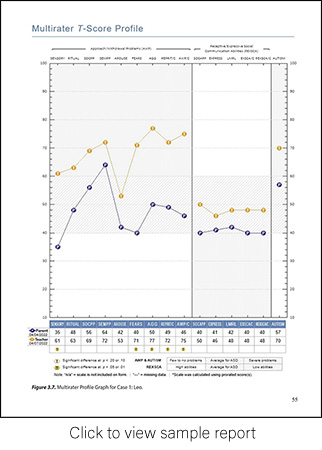Register now and start:
- Accessing PAR Training
- Shopping PAR products & tools
- Using online assessments with PARiConnect

Notice: PAR will close at 4:00 PM EST on Tuesday, December 23rd in observance of the Christmas holiday. Orders placed after 4:00 PM EST on the 23rd, will ship on Friday, December 26th when PAR re-opens at 8:00 AM EST. We wish everyone celebrating a joyful holiday season!

Leo was evaluated at 6 years, 11 months of age for diagnostic confirmation of autism. Leo's PDDBI parent report was consistent with the diagnosis of ASD, with an atypical ASD profile characterized by relatively mild- to- moderate behavior problems and relatively weak social communication skills. His teacher's ratings resulted in a classification of Minimally Verbal ASD characterized by more severe problem behaviors.

The T-Score Profile in the new PDDBI Multirater Report illustrates the cross-informant agreement (i.e., non-significant differences) on several domains under Approach/Withdrawal Problems (AWP) and on all the Receptive/Expressive Social Communication Abilities (REXSCA) domains. However, there were significant discrepancies (marked below the profile with "!!" icons) between parent and teacher reports in three of the AWP domains (SENSORY, FEARS, and AGG) and both associated composites (REPRIT/C and AWP/C). The profile indicates that the parent reported fewer problems at home (T scores in the average range for autism) than the teacher did at school (T scores in the range of severe problems).
Examination of each informant's cluster scores later in the report indicated marked discrepancies in several areas, including auditory and social withdrawal behaviors, problems with caregiver return, and aggressiveness toward others. Supplemental information from Leo's parents and teacher indicated that noise levels at school and Leo's intolerance for change likely played a role in these differences between settings. Understanding the differences between settings helped his school team develop a specific plan to help his teacher manage his behaviors and mitigate his distress.
The PDD Behavior Inventory (PDDBI) is a standardized assessment tool designed to evaluate both adaptive and maladaptive behaviors in children with Autism Spectrum Disorder (ASD). Developed for use by clinicians, educators, and researchers, the PDDBI provides a comprehensive profile of a child’s functioning across multiple domains, including social communication, sensory responses, and behavior regulation. Its unique multirater format allows for input from both parents and teachers, offering valuable insights into how a child’s behaviors may vary across settings. This dual perspective supports more accurate diagnoses, individualized intervention planning, and progress monitoring, making the PDDBI a vital resource in the assessment and support of children with ASD.